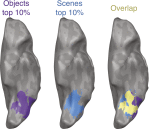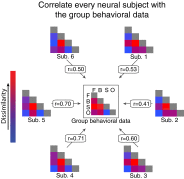Processing multiple visual objects is limited by overlap in neural channels
- PMID: 24889618
- PMCID: PMC4066506
- DOI: 10.1073/pnas.1317860111
Processing multiple visual objects is limited by overlap in neural channels
Abstract
High-level visual categories (e.g., faces, bodies, scenes, and objects) have separable neural representations across the visual cortex. Here, we show that this division of neural resources affects the ability to simultaneously process multiple items. In a behavioral task, we found that performance was superior when items were drawn from different categories (e.g., two faces/two scenes) compared to when items were drawn from one category (e.g., four faces). The magnitude of this mixed-category benefit depended on which stimulus categories were paired together (e.g., faces and scenes showed a greater behavioral benefit than objects and scenes). Using functional neuroimaging (i.e., functional MRI), we showed that the size of the mixed-category benefit was predicted by the amount of separation between neural response patterns, particularly within occipitotemporal cortex. These results suggest that the ability to process multiple items at once is limited by the extent to which those items are represented by separate neural populations.
Keywords: capacity limitations; competition; representational similarity; visual cognition; working memory.
Conflict of interest statement
The authors declare no conflict of interest.
Figures





References
-
- Baddeley AD, Hitch G. Working memory. In: Bower GH, editor. The Psychology of Learning and Motivation: Advances in Research and Theory. New York: Academic; 1974. pp. 47–89.
-
- Duncan J, Martens S, Ward R. Restricted attentional capacity within but not between sensory modalities. Nature. 1997;387(6635):808–810. - PubMed
-
- Gazzaniga M, Ivry RB, Mangun GR. Cognitive Neuroscience. New York: Norton; 2008.
Publication types
MeSH terms
Grants and funding
LinkOut - more resources
Full Text Sources
Other Literature Sources

